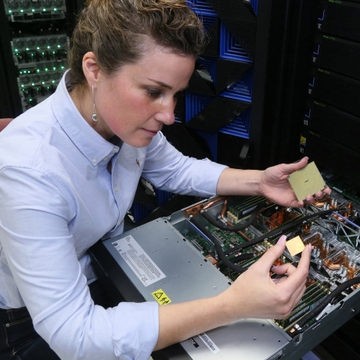Founded in 1887 as a place to educate workers to fuel the industrial revolution, RMIT University is a public university in Melbourne, Australia. Today it prepares students for global enterprise, technology, and design careers. Already serving 87,000 students each year from more than 100 countries, RMIT has expanded its student base through RMIT Online.
RMIT Online is focused on upskilling workers for the next technological revolution. With its first course released in November 2017, RMIT Online now offers 22 courses in its catalog, including courses in AI, VR, and blockchain. “We’re growing emerging skills gaps in the market where there is a lack of university provision,” says Jack Hylands, GM of Strategy and New Product at RMIT Online.
As the RMIT team built the online university offering, they became concerned that traditional learning management systems (LMS), which reinforce a didactic, top-down transfer of knowledge, weren’t interactive enough for today’s students. “The collaboration tools within an LMS are somewhat limited,” says Hylands. “We were very keen to come up with a solution to drive much greater engagement between our students.”
With an emphasis on providing real-world skills—using the type of tools students will encounter in the workplace—Slack quickly became the preferred communication tool for connecting students and faculty with each other and building that engagement.
“The vision for these courses is to develop skills for students that they’re going to be able to use on day one in the office, like Slack,” says Hylands. “The majority of our team all come from a digital background. Slack’s been a very prominent communication tool for a number of years for all of us.”
Early onboarding with Slack keeps students excited about upcoming courses
When RMIT Online students enroll, they automatically get added to Slack as part of that purchase enrollment process. They receive a welcome email that prompts them to join Slack, where they are automatically added to several of the broader student community channels so they can get acquainted with fellow classmates. RMIT Online has found that using Slack in this way gets students prepared for the courses earlier, which in turn improves how they do in the first two weeks of the course.
“Student engagement in the first two weeks of the course is absolutely critical to the likelihood of them successfully completing the course and their engagement through the rest of the course,” says Julian Stevenson, Product Director at RMIT Online. “When we make student Slack onboarding experiences as seamless and simple as possible, that’s one less thing for a student to get flustered about in their first week.”


In many conventional online education settings, a student purchases a course and then has to wait weeks, or even months, before it begins and they start to engage with the instructor and other students. But RMIT Online’s approach eases students into the course and gets them used to using Slack as a means of conversing with other students.
“The excitement of starting a course happens when you buy the course. But if you don’t hear anything for three to four weeks before the course starts, sometimes that enthusiasm wanes. Our quick student onboarding to Slack helps keep students as enthusiastic as the day they enrolled.”
Replacing cumbersome learning management systems with Slack
One of the shortcomings of online education has been the inability to facilitate student and teacher interaction other than through the antiquated forums found in an LMS. RMIT Online saw an opportunity with Slack to better approximate the spontaneous, in-the-moment learning interactions that happen during in-person classes.
“So many of those brilliant learning moments happen in the informal, unstructured environments where people are engaging with each other, asking questions, basically making those connections,” says Hylands. “We’re very much trying to bring a lot of those best parts of the on-campus experience to the virtual environment.”
To simplify these interactions, as each new course starts, RMIT Online’s course managers organize students into smaller course-group Slack channels with one or more industry mentors. For example, in its blockchain course, RMIT creates cohorts of 20 students with one mentor and course manager in each cohort and associated Slack group.
In some ways, the Slack environment has improved on the typical physical classroom interaction, providing students the ability to engage directly with mentors and one another, to go deeper on projects and work together on coursework.
Slack is used as the central channel for all course communications, including:
- As students complete each module of a course, directing them toward having a discussion on Slack with their cohort around the topic
- Announcing guest speakers for weekly course webinars
- Mentors sharing relevant industry news
- Students soliciting feedback from other students on a project
“Slack is at the core of facilitating the ease of those communications, whether it’s the student asking for some help on a technical issue, or debating a new piece of news that relates to the course,” says Hylands.
“We want people to learn and develop skills around their work and around their life. If they have to log in to a website and track down a forum thread that they received an email about, it’s not that useful. Slack fits the bill in terms of that immediate engagement—tap into the app, and get immediately into the conversation.”
Increasing online student participation with Slack
RMIT Online is looking forward to analyzing its first-year results with its Slack-based online learning courses. It plans to measure course progression and completion, project submissions, pass rates, and credentials against industry benchmarks and expects positive results from its unique approach. Further, the lessons learned by the online education team have the potential to help shape the university’s physical classroom approaches as well.
“We’re seeing huge implications for on-campus education,” says Hylands. “As we move away from lecture-style knowledge transfer and into a classroom model where students engage with materials online, students are being encouraged to communicate with their peers and with their academics outside of that face-to-face environment, so they can then use that face-to-face time on campus as an opportunity to engage and collaborate.”
For a university whose mission is to be at the forefront of providing students with career-building skills and real-life experience, it was important to do more than just provide an online version of the campus curriculum. With Slack, RMIT Online has found a unique way to make the most of technology to create a different, potentially more engaging experience for learners.
“We’re not just transferring on-campus, traditionally face-to-face learning through a simple new mode of delivery,” says Hylands. “Instead we are reimagining the educational experience so it can be delivered in an online-first manner, and Slack has been a very important component to reach that goal.”















